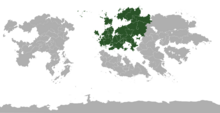Aldinea
 | |
| Area | 28,406,000 km2 (10,968,000 sq mi) |
|---|---|
| Population | TBA |
| Population density | TBA |
| GDP (nominal) | $21.79 trillion |
| GDP (PPP) | $29.01 trillion |
| GDP per capita | $27,310 |
| HDI | |
| Religions | Atruneanism Ihtiram Kelemism Miskism Rodnéwiary Sacralism |
| Demonym | Aldinean |
| Countries | 49 countries |
| Unrecognised states | 2 unrecognized countries See list |
| Languages | Most common first |
| Time zones | UTC−2 to UTC+6 |
| Largest cities | Largest urban movements |
Europe is a continent located entirely in the Northern Hemisphere and mostly in the Eastern Hemisphere. It is bordered by the Ambrosian Sea to the north, the Langeyan Ocean to the west, Miklea to the east and the Lazarene Sea to the south. It comprises the westernmost part of Aldimiklea.
While the border between Aldinea and Miklea is a cultural construct, the continents are commonly considered to be separated by the watershed divides of the TBD mountains to the south, and the drainage basin of the TBD sea to the east aswell as the Nabolonian Straits. The border is however generally unclear and has been changed throughout history, but the division reflects less of a cultural or linguistic divide but more distinct Aldinean identity wishing to distance itself from its neighbours. Several countries including Galideen, Kulavia and Tashbek have their contigous landmasses cross the continental line and are thus considered transcontinental states. In addition Sjealand, Ambrose, Sazarin, Mondejar and Luighne can be considered transcontinental because of their overseas island or territories but are generally not due to the vast distance between them and their territories.
Aldinea covers 28,406,000 square kilometres which is about 6% of the earths surface (18% of land area). Politically the continent is home to around fifty states of various degrees of recognition, with Kulavia being the largest and most populous. As of 2019 Aldinea is home to 1,1 billion people making it the third most populous continent in the world. The Aldinean climate is largely affected by warm Langeyan currents that temper winters and summers on much of the continent, even at latitudes along which the climate in Miklea and Farvara is severe. Further from the sea, seasonal differences are more noticeable than close to the coast.
The Aquiline League is considered by most as the birthplace of Aldinean civilization, havign spread across the entire southern Aldinean coast by the early 2nd century. Despite the fall of the league by the 6th century and subsequent migrations into its territories by Rekan and Fulkaic peoples, the economic and administrative legacy of the hundreds of member cities heavily influnced later governments.
Name
Aldinea and Miklea
History
Antiquity
Middle Ages
Gilded Age
Age of Expansion
Imperial Age
Volatile Years
Modern Age
Geography
Climate
Geology
Flora
Fauna
Politics
List of States and territories
| Country | Area (km²) | Population | HDI | Capital |
|---|---|---|---|---|
| TBA | 11,400,000 | 0.766 | Elsbridge | |
| File:CradebetianWikiFlag.png Cradebetia | TBD | 12,409,000 | 0.702 | Sudbrigge |
| 1,386,000 | 17,127,051 | 0.901 | Wittburg | |
| 1,966,086 | 32,657,434 | 0.954 | Asgård | |
| TBD | 21,078,000 | 0.793 | Mulford | |
| Total | TBD | 1,181,636,876 | ||